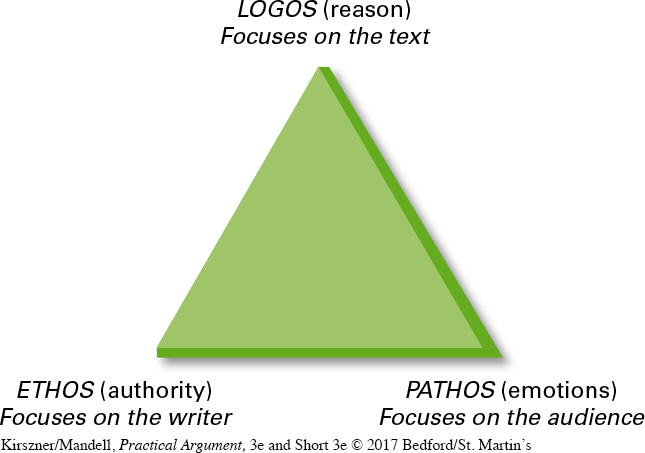The Rhetorical Triangle
The relationship among the three kinds of appeals in an argument is traditionally represented by a triangle.
In the diagram above—called the rhetorical triangle—all sides of the triangle are equal, implying that the three appeals occur in an argument in equal measure. In reality, however, this is seldom true. Depending on the audience, purpose, and situation, an argument may include all three appeals or just one or two. Moreover, one argument might emphasize reason, another might stress the writer’s authority (or credibility), and still another might appeal mainly to the emotions. (In each of these cases, one side of the rhetorical triangle would be longer than the others.) In academic writing, for example, the appeal to reason is used most often, and the appeal to the emotions is less common. As Aristotle recognized, however, the three appeals often work together (to varying degrees) to create an effective argument.
Each of the following paragraphs makes an argument against smoking, illustrating how the appeals are used in an argument. Although each paragraph includes all three of the appeals, one appeal outweighs the others. (Keep in mind that each paragraph is aimed at a different audience.)
Among young people, the dangers of smoking are clear. According to the World Health Organization, smoking can cause a variety of problems in young people—for example, lung problems and shortness of breath. Smoking also contributes to heart attacks, strokes, and coronary artery disease (72). In addition, teenage smokers have an increased risk of developing lung cancer as they get older (CDC). According to one study, teenage smokers see doctors or other health professionals at higher rates than those who do not smoke (Ardly 112). Finally, teenagers who smoke tend to abuse alcohol and marijuana as well as engage in other risky behaviors (CDC). Clearly, tobacco is a dangerous drug that has serious health risks for teenage smokers. In fact, some studies suggest that smoking takes thirteen to fourteen years off a person’s life (American Cancer Society).
APPEAL TO THE EMOTIONS (PATHOS)
Every day, almost four thousand young people begin smoking cigarettes, and this number is growing (Family First Aid). Sadly, most of you have no idea what you are getting into. For one thing, smoking yellows your teeth, stains your fingers, and gives you bad breath. The smoke also gets into your hair and clothes and makes you smell. Also, smoking is addictive; once you start, it’s hard to stop. After you’ve been smoking for a few years, you are hooked, and as television commercials for the nicotine patch show, you can have a hard time breaking the habit. Finally, smoking is dangerous. In the United States, one out of every five deaths can be attributed to smoking (Teen Health). If you have ever seen anyone dying of lung cancer, you understand how bad long-term smoking can be. Just look at the pictures on the Internet of diseased, blackened lungs, and it becomes clear that smoking does not make you look cool or sophisticated, no matter what cigarette advertising suggests.
APPEAL TO AUTHORITY (ETHOS)
My advice to those who are starting to smoke is to reconsider—before it’s too late. I began using tobacco over ten years ago when I was in high school. At first, I started using snuff because I was on the baseball team and wanted to imitate the players in the major leagues. It wasn’t long before I had graduated to cigarettes—first a few and then at least a pack a day. I heard the warnings from teachers and the counselors from the D.A.R.E. program, but they didn’t do any good. I spent almost all my extra money on cigarettes. Occasionally, I would stop—sometimes for a few days, sometimes for a few weeks—but I always started again. Later, after I graduated, the health plan at my job covered smoking cessation treatment, so I tried everything—the patch, Chantix, therapy, and even hypnosis. Again, nothing worked. At last, after I had been married for four years, my wife sat me down and begged me to quit. Later that night, I threw away my cigarettes and haven’t smoked since. Although I’ve gained some weight, I now breathe easier, and I am able to concentrate better than I could before. Had I known how difficult quitting was going to be, I never would have started in the first place.
When you write an argumentative essay, keep in mind that each type of appeal has its own particular strengths. Your purpose and audience as well as other elements of the rhetorical situation help you determine what strategy to use. Remember, however, that even though most effective arguments use a combination of appeals, one appeal predominates. For example, even though academic arguments may employ appeals to the emotions, they do so sparingly. Most often, they appeal primarily to reason by using facts and statistics—not emotions—to support their points.
For more practice, see the LearningCurve on Persuasive Appeals (pathos, ethos, and logos) in this LaunchPad.
